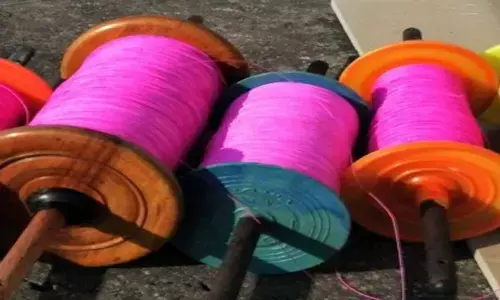It's high time India puts curbs on wheat exports

All eyes have now turned to wheat exports. With at least 55 countries, which were largely dependent on food supplies coming from the Russia-Ukraine region, now scouting the globe to fill up the gap in wheat availability, the demand for wheat exports from India has never been so high.
All eyes have now turned to wheat exports. With at least 55 countries, which were largely dependent on food supplies coming from the Russia-Ukraine region, now scouting the globe to fill up the gap in wheat availability, the demand for wheat exports from India has never been so high. With Russia-Ukraine region supplying almost 60 million tonnes of wheat, and with trade activities hit by continuing war and economic sanctions, the world is finding it difficult to fill the void.
With its grain silos overflowing, India is in a position to meet the growing wheat needs to some extent. So much so that a trader has reportedly booked 1,100 freight trains to carry wheat from Madhya Pradesh to the Kandla port. This tells you how enthusiastic the trade is at the trade prospects that the Russian invasion of Ukraine has opened up. From 2.1 million tonnes of wheat exported in 2020-21 to a significant increase to 7.85 million tonnes in 2021-22, the private trade (what ITC had claimed) is seeing an export potential of 21 million tonnes this year clearly showing how lucrative is the opportunity that a geopolitical crisis has created.
While the trade is upbeat, a word of caution has perhaps brought the Indian government to restrict the supply of freight trains. This is because of growing fears of an unexpected increase in atta prices in the months to come emerging from a strain in supplies that may eventually begin to pinch the household budget. The move is intended to ensure adequate domestic supplies by ensuring that enough freight capacity exists for the Food Corporation of India (FCI) to move grains to the deficit areas. At the same it will ease the pressure on wheat growing states, already overflowing with procured stocks.
This year, the government has done well to revise the wheat production targets, lowering it from the proposed 111.34 million tonnes to 105 million tonnes. The sudden spike in the temperatures in the early part of the month of March, at a time of grain filling in wheat spikes, had resulted in shrivelling of grains thereby causing a loss in yield. In Punjab, crop cutting experiments by the Department of Agriculture & Farmers Welfare, the scientific way to assess the crop yield, has shown a drop of 5 quintals per acre. Coming at a time when private trade has purchased almost 5.89-lakh tonnes of wheat from the mandis at a price higher than the MSP of Rs 2,015 per quintal, Punjab is not likely to achieve the procurement target of 13.5 million tonnes. With the peak marketing season already behind us, it is expected wheat procurement in Punjab will not even touch 10 million tonnes. Similarly, in Haryana, wheat procurement has come down by more than 42 per cent this year.
Against a target of 44.4 million tonnes of wheat procurement, I doubt if the procurement this year will even touch 20 million tonnes. Last year, wheat procurement had touched 43.3 million tonnes.
Considering that India requires annually about 26 million tonnes for the public distribution system (PDS) and another 18 million tonnes or so for the Pradhan Mantri Garib Kalian Yojna – under which 5 Kg of wheat is supplied free of cost to about 800 million people, a scheme that began during the pandemic – and which has been extended till September, India will have to keep a close watch to ensure there is enough wheat quantity is available to meet the domestic needs, before the next wheat harvest begins in April 2023. After all, just like the sudden heat wave that hit the standing wheat crop this year, we can't be sure of any similar climatic aberration not happening in the year to come.
For this reason, I think India needs to impose an upper limit for wheat exports, not exceeding 12 million tonnes this year. Despite the excitement that traders are exhibiting, we have to doubly careful.
Let us not repeat the same mistake that had left India with no choice but to go for huge imports at a time when there was no shortfall in domestic production. It had happened in 2005-06 when India allowed the private trade to buy wheat directly from farmers. Private trade had moved in a big way mopping as much grain from farmers as possible. So much so that when it came to assessing the requirement for PDS purposes, no company was willing to disclose the stocks it carried. As a result, and not willing to take any chances, India had to go in for imports. It imported more than 5.5 million tonnes of wheat in 2006-07.
When a country like India enters the global market, the prices zoom. India had to make the imports at prices that were almost double than what it had paid to farmers. A controversy erupted, and so much so that the BJP, then in the Opposition, had demanded a CBI enquiry.
Beware of the Ideas of March, as Shakespeare had said. I am sure that despite all the claims to the contrary, the Ministry for Food and Consumer Affairs would be careful enough not to repeat the mistake again. Let it be loud and clear that this year that it wouldn't be even possible to buy at a much higher price given that there are no supplies available off the shelves globally.
One of the strongest lessons that the Russia-Ukraine conflict has brought out is the need for each country to be self-sufficient in food, as much as possible. Take a country like Egypt, which sources nearly 80 per cent of its wheat requirement from Russia-Ukraine region, and is now searching globally to source wheat. It should in reality be making a serious effort in achieving self-sufficiency in wheat, a staple crop. Many research studies show that Egypt cannot be attaining complete self-sufficiency in wheat, but an effort should be made to reduce the dependency. Even if Egypt can produce at best 68 per cent of its requirement domestically, as some studies suggest, I think the popular leader and its President, Abdel Fattah al-Sisi, should launch a drive to increase wheat production. This should be followed with an initiative to diversify food habits so as the reduce the intake of wheat.
The biggest hurdle in attaining food self-sufficiency comes from strong lobbying by market apologists (and that includes a dominant class of mainline economists) who would always contest saying that the effort instead should be to increase dependence on international agricultural supply chains. But political leadership must understand how critical this route is to meet the food security needs. Even before the war, agricultural commodity pricing had touched a steep high, and the world was already staring at a food crisis. As per the FAO food index, commodity prices had already gone beyond the price range exhibited at time of the World Food Crisis in 2007-08. At that time, let's not forget that as many as 37 countries had faced food riots.
(The author is a noted food policy analyst and an expert on issues related to the agriculture sector. He writes on food, agriculture and hunger)














